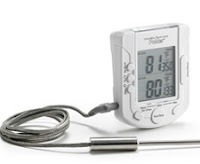 If we'd wanted these ribeye steaks to turn out any better than they did, I don't know what we could have done to make them so. The recipe is very exact in its cooking method, and with the help of my meat/oven thermometer, they cooked to perfection. The smear underneath is a puckery sauce made ahead and plopped on the hot plate just before serving.
If we'd wanted these ribeye steaks to turn out any better than they did, I don't know what we could have done to make them so. The recipe is very exact in its cooking method, and with the help of my meat/oven thermometer, they cooked to perfection. The smear underneath is a puckery sauce made ahead and plopped on the hot plate just before serving.
Up until last night's dinner, we've been a bit disappointed with steak we've purchased lately. The Costco ribeyes weren't all that tender, and even the steaks from Whole Foods weren't very tasty or tender, either. So we decided to splurge on our next steak dinner and buy U.S.D.A. Prime meat, only available at a local, independent butcher (Pacific Ranch Market in Orange Park Acres).
It was money well spent, as these steaks were outstanding in every way. The recipe comes from Hugh Carpenter, a prolific cookbook author and entertaining instructor. He came to my attention about 16 years ago with classes he taught in Los Angeles and Pasadena. I've purchased several of his books, and a couple of years ago he taught a grill or barbecue class at Sur la Table in Newport Beach (SLT is rarely doing guest chefs anymore, so don't look for him there or at any other SLT store . . . perhaps I'll write a rant about the Sur la Table cooking school on another posting . . . I used to be a big fan, but no longer). This was the recipe he prepared that night, and it's been a success every time. I believe it's from his book Hot Barbecue printed a few years ago, which I do not own.
Buy the best quality meat you can afford. Make sure you have a very reliable meat thermometer like the one pictured here.  This little number has been a lifesaver for me more times than I can count. And as good as anyone thinks he/she is as a grill king, it will make a believer out of you that every cook needs one. This particular model by Polder tracks the temperature in the grill oven as well as the food so you can make adjustments. The method of cooking is this: the steak is marinated for a few hours. Meanwhile, make the Amazing Glaze sauce and allow it to cool.
This little number has been a lifesaver for me more times than I can count. And as good as anyone thinks he/she is as a grill king, it will make a believer out of you that every cook needs one. This particular model by Polder tracks the temperature in the grill oven as well as the food so you can make adjustments. The method of cooking is this: the steak is marinated for a few hours. Meanwhile, make the Amazing Glaze sauce and allow it to cool.
After removing some to serve on the finished plate, drain the steaks, blot them dry and let them sit in remaining glaze for about 40 minutes. Heat grill to medium high, sear the steaks for one minute on each side, then put them on a rack on a baking sheet and place back in the grill at 300° but
not over the direct heat. Watch the meat thermometer carefully and remove them when they hit 120°. Allow to sit for 5 minutes covered loosely with foil. Serve! You won't be disappointed.
Happy grilling . . .
Ribeye Steaks with Amazing Glaze
Recipe By :Hugh Carpenter, cookbook author
Serving Size : 4 Preparation Time :0:30
48 ounces steaks -- 4 ribeyes, 12 ounces each
10 ounces Worcestershire sauce
3 whole lemons -- squeezed
1/4 cup water
1 tablespoon olive oil
1/2 whole yellow onion -- chopped
6 cloves garlic -- minced
2 tablespoons fresh thyme
2 cups red wine
1 1/2 cups Heinz 57 Sauce
3 tablespoons brown sugar
2 1/2 tablespoons dark sesame oil
2 tablespoons chili powder
1 tablespoon molasses
1 tablespoon fresh oregano
1 tablespoon paprika
1/2 tablespoon fresh sage
1/4 teaspoon Tabasco sauce
1. Place the steaks in a large rectangular container. In a small bowl combine the Worcestershire sauce, lemon juice and water. Pour over the meat and chill for 1-8 hours.
2. Meanwhile, prepare the Sauce: In a 2 1/2 quart saucepan add oil and onion. Sauté until onions are translucent, about 8 minutes. Add garlic and continue cooking for just 30 seconds. Add all remaining ingredients, bring to a boil, cover, reduce heat to simmer and cook for 20 minutes. Remove lid, increase heat and boil until the sauce has reduced about half. Transfer to a bowl, cool, cover and refrigerate.
3. Set aside one cup of the sauce to serve with the meat. Drain and discard the meat marinade. Blot the steaks of excess liquid, then spread remaining sauce liberally over the steaks, to coat evenly.
4. Grilling meat: Preheat oven to 300°. Use convection, if available. Then preheat a stovetop grill over high heat. Grill steaks on hot grill and cook about 1 minute per side. Place steaks in oven on a rack, on a baking sheet and insert a meat thermometer in the center of one steak. Bake about 15 minutes, or until the internal temperature is about 120° - 130°. At 120° = medium rare, at 130° = medium. Cut into one steak when it is about 5° below desired temp. It may require a few more minutes, depending on your oven temperature.
5. Remove steaks from oven and allow to sit for about 5 minutes. Slice steak into thin slices and serve on a heated plate with a puddle of the sauce beneath it.
6. If you would prefer to use a GAS GRILL, preheat it to medium heat. Brush the grill with oil, then lay on the steaks, marking them, but cooking no longer than that. Have ready a rimmed baking sheet with a rack, and place steaks on the rack in the grill, but not over direct heat. Reduce heat to 300°. Insert meat thermometer, close lid and continue to cook until meat reaches temperature desired (see above). Allow to cool 5 minutes before serving.
Start to Finish Time: 2:15
Serving Ideas : This is best served with a smooth carb - like garlic mashed potatoes or creamy polenta. Grilled onions make a good accompaniment as well.
NOTES : Sauce is very spicy. If you prefer more highly seasoned, add more Tabasco. And this recipe assumes a VERY hearty eater with 12 ounces of steak per person. Most people would eat an 8 ounce steak. Another option: buy bigger ribeyes and cut them in half after they're grilled. The "secret" to this recipe is the cooking method and it has worked perfectly every time. We take the steaks off at 120° and let them sit for a few minutes covered lightly with foil.
To print the recipe only, click on the title at the top.






